Bch 403 cumulative Study guides, Class notes & Summaries
Looking for the best study guides, study notes and summaries about Bch 403 cumulative? On this page you'll find 8 study documents about Bch 403 cumulative.
All 8 results
Sort by
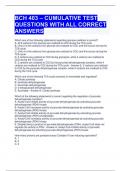
-
BCH 403 – CUMULATIVE TEST QUESTIONS WITH ALL CORRECT ANSWERS
- Exam (elaborations) • 24 pages • 2024
- Available in package deal
-
- $12.99
- + learn more
BCH 403 – CUMULATIVE TEST QUESTIONS WITH ALL CORRECT ANSWERS Which one of the following statements regarding glucose oxidation is correct? A. All 6 carbons from glucose are oxidized to CO2 during the TCA cycle B. Only 2 of the carbons from glucose are oxidized to CO2, and this occurs during the TCA cycle. C. Only 4 of the carbons from glucose are oxidized to CO2, and this occurs during the TCA cycle D. 2 carbons are oxidized to CO2 during glycolysis, while 4 carbons are oxidized to CO2 d...
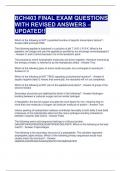
-
Bundle For BCH 403 FINAL TEST QUESTIONS WITH VERIFIED ANSWERS
- Package deal • 4 items • 2024
-
- $26.59
- + learn more
BCH 403 – CUMULATIVE TEST QUESTIONS WITH ALL CORRECT ANSWERS 2 Exam (elaborations) BCH 403 FINAL TEST QUESTIONS WITH VERIFIED ANSWERS 3 Exam (elaborations) BCH403 FINAL EXAM QUESTIONS WITH REVISED ANSWERS – UPDATED!! 4 Exam (elaborations) BCH403 PRACTICE TEST QUESTIONS WITH CERTIFIED ANSWERS
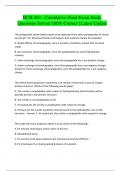
-
BCH 403 - Cumulative Final Exam Study Questions Solved 100% Correct | Latest Update
- Exam (elaborations) • 40 pages • 2024
-
- $13.49
- + learn more
The polypeptide shown below needs to be separated from other polypeptides of similar size (at pH 7.0). What purification technique is best suited to isolate this peptide? A. Nickel affinity chromatography, since it contains a histidine residue that can bind metal. B. Size exclusion chromatography, since the polypeptide has some hydrophobic residues. C. Anion exchange chromatography, since the polypeptide has a net positive charge. D. Anion exchange chromatography, since the polypeptide ha...
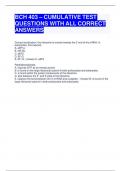
-
BCH 403 – CUMULATIVE TEST QUESTIONS WITH ALL CORRECT ANSWERS
- Exam (elaborations) • 25 pages • 2024
- Available in package deal
-
- $13.99
- + learn more
BCH 403 – CUMULATIVE TEST QUESTIONS WITH ALL CORRECT ANSWERS During translocation, the ribosome is moved towards the 3' end of the mRNA. In eukaryotes, this requires: A. eEF1α. B. eEF1βγ. C. eEF2. D. EF-G. E. EF-Ts - Answer-C. eEF2 Peptidyltransferase: A. requires GTP as an energy source. B. is found on the large ribosomal subunit in both prokaryotes and eukaryotes. C. is found within the protein components of the ribosome. D. acts between the P- and E-sites of the ribosome. ...

-
Bundle For BCH 403 FINAL TEST QUESTIONS WITH VERIFIED ANSWERS
- Package deal • 4 items • 2024
-
- $26.99
- + learn more
BCH403 PRACTICE TEST QUESTIONS WITH CERTIFIED ANSWERS 2 Exam (elaborations) BCH403 FINAL EXAM QUESTIONS WITH REVISED ANSWERS – UPDATED!! 3 Exam (elaborations) BCH 403 FINAL TEST QUESTIONS WITH VERIFIED ANSWERS 4 Exam (elaborations) BCH 403 – CUMULATIVE TEST QUESTIONS WITH ALL CORRECT ANSWERS
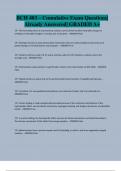
-
BCH 403 – Cumulative Exam Questions| Already Answered| GRADED A+
- Exam (elaborations) • 34 pages • 2024
-
- $19.25
- + learn more
T/F: The thermodynamics of a biochemical reaction can be driven by either favorable changes in enthalpy or favorable changes in entropy, but not by both. - ANSWER-False T/F: Hydrogen bonds are weak electrostatic interactions that are made possible by the presence of partial charges on H-bond donors and acceptors. - ANSWER-True T/F: Carbonic acid has a pKa of 6.37; acetic acid has a pKa of 4.76; therefore, carbonic acid is the stronger acid. - ANSWER-False T/F: Small proteins elute earliest...
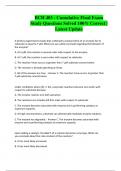
-
BCH 403 - Cumulative Final Exam Study Questions Solved 100% Correct | Latest Update
- Exam (elaborations) • 41 pages • 2024
-
- $13.99
- + learn more
C. I cannot make any conclusions about the rate constant with this information. D. It is definitely a first order rate constant. E. The catalyst is not very efficient. - Answer A. It has most likely increased. T/F: The thermodynamics of a biochemical reaction can be driven by either favorable changes in enthalpy or favorable changes in entropy, but not by both. - Answer False T/F: Hydrogen bonds are weak electrostatic interactions that are made possible by the presence of partial charges o...
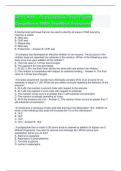
-
BCH 403 - Cumulative Final Exam Questions With Verified Answers
- Exam (elaborations) • 24 pages • 2024
-
- $10.99
- + learn more
BCH 403 - Cumulative Final Exam Questions With Verified Answers A biochemical technique that can be used to identify all areas of DNA bound by histones is called: A. DNA-seq. B. ChIP-seq. C. DNase-seq. D. RNA-seq. E. Proteomics. - Answer-B. ChIP-seq /.A company has developed an effective inhibitor for an enzyme. The structure of the inhibitor does not resemble the substrate of the reaction. Which of the following is also likely to be true upon addition of the inhibitor? A. The fi...

How did he do that? By selling his study resources on Stuvia. Try it yourself! Discover all about earning on Stuvia


